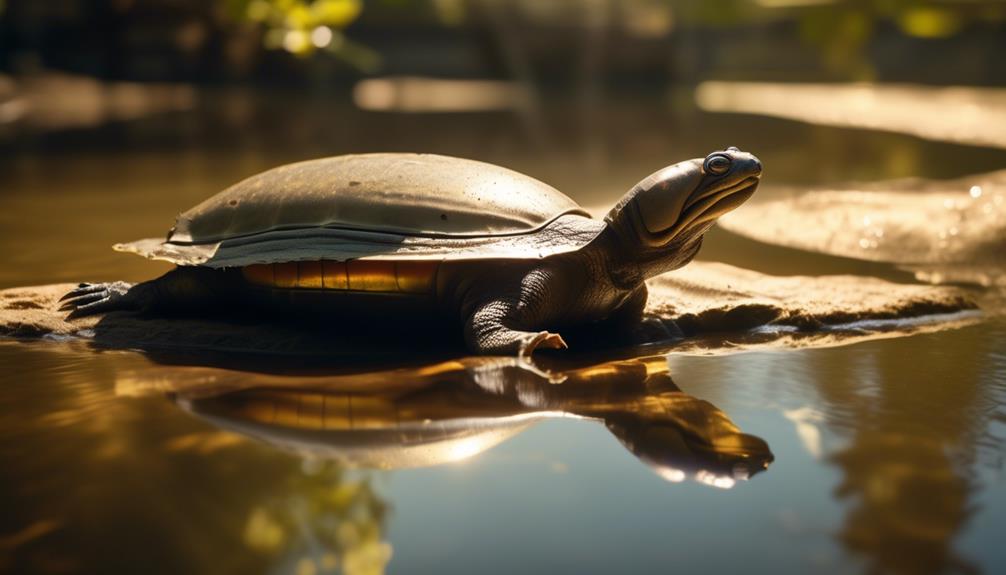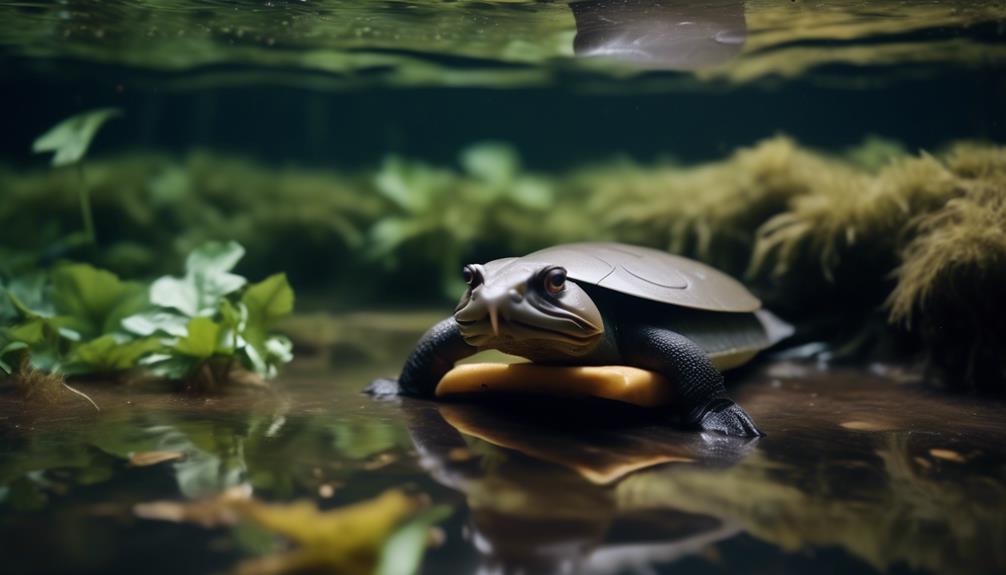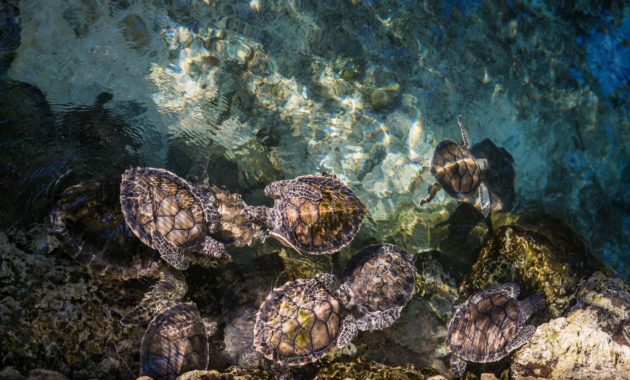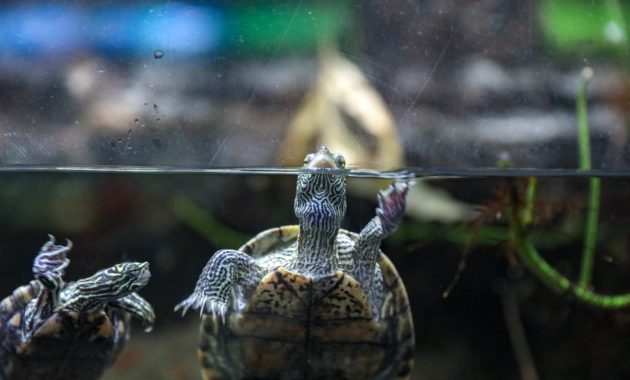
Curiosity may have killed the cat, but it’s what keeps us humans searching for the unknown. And today, we invite you to unravel the mysteries of the aquatic world as we delve into the realm of elusive predators.
Among them, the Smooth Softshell Turtles reign supreme, with their stealthy nature and intriguing adaptations. But what makes these creatures so fascinating? Well, let’s just say that their smooth carapace and hidden secrets are just the tip of the iceberg.
So, prepare to be captivated as we uncover the elusive world of these aquatic hunters and the wonders that lie beneath the surface.
Key Takeaways
- Smooth Softshell Turtles are medium-sized turtles that can grow up to 14 inches in length and have a lifespan of 20+ years.
- They are naturally found in unpolluted bodies of water such as large streams, big lakes, and rivers, with a preference for sandy or muddy bottoms.
- Smooth Softshell Turtles have a smooth, flat, leathery carapace without bony scutes, and females are larger than males.
- They require a spacious enclosure with clean, filtered water, a sandy substrate for hiding, and a slanted basking site with a warming light. Their diet consists primarily of small fish, aquatic plants, and insects, and they should be handled with care to avoid scratches or bites.
Size and Lifespan
Smooth Softshell Turtles are medium-sized turtles that can grow up to a length of around 14 inches and have a lifespan of 20+ years. These turtles aren’t too big, making them manageable and suitable for various types of enclosures. You can provide them with a spacious habitat where they can comfortably move around. They won’t outgrow their enclosure quickly, allowing you to enjoy their company for many years.
With proper care and a suitable environment, Smooth Softshell Turtles can live a long and healthy life. So, if you’re considering getting one as a pet, be prepared for a long-term commitment. Remember to provide them with the necessary space, diet, and care to ensure they thrive and live a fulfilling life.
Habitat and Distribution

If you’re considering getting a Smooth Softshell Turtle as a pet, it’s important to understand their natural habitat and distribution. Here are some key points to know:
- Habitat: Smooth Softshell Turtles are naturally found in unpolluted bodies of water such as large streams, big lakes, and rivers. They prefer sandy or muddy bottoms and often bury themselves in the sand or mud underwater when they want to be undisturbed. Water serves as their retreat when threatened.
- Distribution: These turtles can be found in the Mississippi River drainage and its tributaries from Minnesota to Louisiana. They’re also found in North Dakota, South Dakota, western Pennsylvania, Oklahoma, Nebraska, Kansas, and Texas.
- Environmental Requirements: Smooth Softshell Turtles require a spacious enclosure with clean, filtered water. A sandy substrate should be provided for hiding, and the water should be shallow enough for the turtle to reach the surface with its long neck. A slanted basking site with a warming light should also be included.
- Care: Maintaining proper water and air temperatures, providing a multi-spectrum light bulb, and keeping them alone to avoid potential harm from other turtle species are essential for their well-being.
Understanding the habitat and distribution of Smooth Softshell Turtles will help you create an appropriate environment for their care and ensure their health and happiness as pets.
Description and Colors

Smooth Softshell Turtles have a unique appearance. Their carapace, or shell, is smooth and flat, lacking the bony scutes found in other turtle species. It’s leathery and flexible at the edges. The nose of the turtle tapers and comes to a point.
When it comes to colors, adult males are generally gray or brown, adorned with small dots and dashes on their back. On the other hand, adult females are brown or tan, with dark brown irregular blotches. These colors help them blend in with their sandy or muddy habitats.
Environment and Care Requirements

To provide optimal care for Smooth Softshell Turtles, it’s important to create an environment that meets their specific requirements. Here are four key considerations for their care:
- Spacious Enclosure: As these turtles grow to a medium size, they need a spacious enclosure to move around comfortably.
- Clean, Filtered Water: Clean and filtered water is crucial for their health. Ensure the water is regularly changed and properly filtered to maintain water quality.
- Sandy Substrate: Provide a sandy substrate in the enclosure for hiding. Smooth Softshell Turtles like to bury themselves in the sand or mud underwater when they want to be undisturbed.
- Basking Site and Lighting: Include a slanted basking site with a warming light. The tank should also be lit with a multi-spectrum light bulb, and the water and air temperatures should be maintained within specific ranges.
Diet and Behavior

Now let’s explore the dietary needs and behavior of Smooth Softshell Turtles.
These turtles are primarily carnivorous, feeding on small fish, aquatic plants, and aquatic insects. While commercial turtle pellets can be used as a foundation for their diet, it’s important to provide a variety of live prey to ensure their nutritional needs are met.
Smooth Softshell Turtles are strong and fast swimmers, using their agility to catch prey in the water.
When it comes to their behavior, it’s best to limit handling them to necessary times, as they may scratch or bite when picked up. It’s also important to handle them with care, keeping their face away from your fingers to avoid any potential harm.
Spacious Enclosure

Creating a spacious enclosure is essential for the well-being of Smooth Softshell Turtles as they grow to a medium size. Here are four reasons why a spacious enclosure is important for these elusive aquatic predators:
- Room to roam: Smooth Softshell Turtles need space to swim and explore. A larger enclosure allows them to exercise their natural behaviors and prevents them from feeling cramped or stressed.
- Proper filtration: With a spacious enclosure, it’s easier to maintain clean, filtered water. This is crucial for the turtles’ health and helps prevent the buildup of harmful bacteria or toxins.
- Hiding spots: Smooth Softshell Turtles require a sandy substrate for hiding. A spacious enclosure allows for the creation of multiple hiding spots, giving the turtles a sense of security and allowing them to exhibit their natural behavior of burying themselves in sand or mud.
- Basking area: These turtles also need a slanted basking site with a warming light. A spacious enclosure provides enough room to include this essential feature, allowing the turtles to regulate their body temperature and promote overall well-being.
Clean, Filtered Water

Clean, filtered water is crucial for the health of Smooth Softshell Turtles. It provides them with a suitable environment to thrive. These turtles naturally inhabit unpolluted bodies of water such as streams, lakes, and rivers. Unclean water can contain harmful pollutants and bacteria that can negatively affect the health of the turtles. Clean, filtered water ensures that they have access to a safe and hygienic habitat.
Additionally, smooth softshell turtles rely on water for various activities, including swimming, hunting, and regulating their body temperature. Without clean, filtered water, these turtles may become stressed, susceptible to diseases, and unable to carry out their natural behaviors effectively.
Therefore, maintaining clean, filtered water is crucial for the overall well-being of Smooth Softshell Turtles.
Sandy Substrate for Hiding

To ensure the well-being of Smooth Softshell Turtles, providing a sandy substrate for hiding is essential. Here are four reasons why this is important:
- Camouflage: The sandy substrate allows the turtles to blend in with their environment, making it easier for them to stay hidden from predators.
- Burrowing: Smooth Softshell Turtles have a natural instinct to bury themselves in the sand or mud when they want to be undisturbed. The sandy substrate provides them with a suitable place to dig and hide.
- Protection: The sand acts as a buffer, offering protection to the turtles from the elements and potential harm.
- Natural Behavior: Creating a habitat that mimics their natural environment is crucial for the overall well-being of these turtles. By providing a sandy substrate, you’re allowing them to exhibit their natural behaviors and instincts.
Shallow Water for Neck Reach

Make sure to provide shallow water for Smooth Softshell Turtles so that they can easily reach the surface with their long necks. These elusive aquatic predators have a unique adaptation that allows them to extend their necks and breathe while submerged.
By creating a shallow water area in their enclosure, you’re ensuring that they’ve easy access to the surface. This is essential for their well-being and natural behavior. Smooth Softshell Turtles rely on their long necks to hunt for prey, survey their surroundings, and bask in the sun.
Without shallow water, they’d struggle to reach the surface and may become stressed or even drown. So, make sure to include a shallow water area in their habitat to provide them with a comfortable and accessible environment.
Slanted Basking Site With Warming Light

To provide optimal basking conditions for Smooth Softshell Turtles, ensure that their enclosure includes a slanted surface and a warming light. Here’s what you need to know:
- Slanted surface: The basking area should be sloped to allow the turtles to easily climb out of the water and onto the platform. This mimics their natural habitat and provides them with a comfortable spot to rest and soak up the heat.
- Warming light: A heat lamp or basking light is essential to provide the turtles with the necessary warmth. This light should be positioned over the basking area to create a temperature gradient, allowing the turtles to regulate their body temperature by moving closer or farther away from the light.
- Temperature control: Monitor the temperature of the basking area to ensure it stays within the recommended range of 85-95°F (29-35°C). Use a thermometer to accurately measure the temperature and make adjustments as needed.
- Photoperiod: Mimic the natural day-night cycle by providing 12-14 hours of light followed by 10-12 hours of darkness. This helps regulate their biological rhythms and promotes natural behaviors.
Lighting and Temperature Requirements

Smooth Softshell Turtles require specific lighting and temperature conditions to thrive in captivity.
When it comes to lighting, they need a tank that’s well-lit with a multi-spectrum light bulb. This type of bulb will provide the necessary UVB rays that help with the synthesis of vitamin D3, which is essential for their overall health.
In terms of temperature, the water and air temperatures should be maintained within specific ranges. The water temperature should be around 75 to 85 degrees Fahrenheit, while the air temperature should be around 80 to 85 degrees Fahrenheit.
It’s important to ensure that these conditions are met in order to create a suitable and comfortable environment for the Smooth Softshell Turtles to live in.
Keeping Smooth Softshell Turtles Alone

If you want to ensure the safety and well-being of your Smooth Softshell Turtle, it’s best to keep them alone in their enclosure. Here are four reasons why:
- Aggression: Smooth Softshell Turtles can be aggressive towards other turtles, especially when it comes to territory and food. Keeping them alone will prevent any potential conflicts and ensure a stress-free environment for your turtle.
- Disease transmission: Turtles can carry various diseases that can be transmitted to other turtles. By keeping your Smooth Softshell Turtle alone, you reduce the risk of disease transmission and protect the health of your pet.
- Feeding habits: Smooth Softshell Turtles have specific dietary requirements and feeding habits. By keeping them alone, you can closely monitor their food intake and ensure they receive the proper nutrition they need to thrive.
- Space and comfort: Smooth Softshell Turtles require a spacious enclosure to accommodate their medium size. Keeping them alone allows them to have ample space to swim, bask, and explore without feeling cramped or stressed.
Carnivorous Diet

Smooth Softshell Turtles thrive on a carnivorous diet consisting primarily of small fish, aquatic plants, and aquatic insects. These elusive predators are skilled hunters in the water, using their long necks and streamlined bodies to swiftly capture their prey. They’re opportunistic feeders, taking advantage of any available food source in their habitat.
Their diet typically includes small fish, such as minnows and shiners, which they catch with their sharp beaks. They also consume a variety of aquatic plants, such as duckweed and water lettuce, which provide essential nutrients. Additionally, they feed on aquatic insects, such as dragonfly larvae and mosquito larvae, which are abundant in their watery environment.
This carnivorous diet ensures that Smooth Softshell Turtles obtain the necessary nutrients to thrive and survive in their aquatic home.
Commercial Turtle Pellets

To ensure a well-rounded diet for your Smooth Softshell Turtle, consider incorporating commercial turtle pellets into its carnivorous feeding regimen. These specially formulated pellets provide essential nutrients that may be lacking in a solely carnivorous diet.
Here are four reasons why commercial turtle pellets are beneficial for your turtle:
- Balanced nutrition: Commercial turtle pellets are designed to provide a balanced mix of proteins, vitamins, and minerals, ensuring that your turtle receives all the necessary nutrients for optimal health.
- Convenience: These pellets are readily available and easy to store, making them a convenient option for feeding your turtle. They eliminate the need to constantly source live prey or prepare complex meals.
- Dental health: Chewing on the pellets helps maintain your turtle’s jaw strength and dental health. The firm texture of the pellets helps prevent overgrown beaks and dental issues.
- Variety: Commercial turtle pellets come in different flavors and sizes, providing your turtle with a varied diet. This variety can help prevent boredom and encourage natural foraging behaviors.
Handling and Safety Precautions

When it comes to handling Smooth Softshell Turtles, there are a few important considerations to keep in mind. First and foremost, it’s crucial to limit handling to necessary times. This is because these turtles may scratch or bite when picked up. It’s important to exercise caution and take extra care to keep their face away from fingers to avoid any potential harm.
In addition to handling, providing the turtles with a suitable enclosure is essential for their safety and well-being. This includes ensuring they have a spacious enclosure that meets their environmental needs. This includes providing clean, filtered water for them to swim in and a sandy substrate for hiding.
Furthermore, their tank should have a slanted basking site with a warming light. This allows the turtles to bask and regulate their body temperature effectively. It’s important to maintain the water and air temperatures within specific ranges to ensure their comfort and overall health.
Frequently Asked Questions
Are Smooth Softshell Turtles Good Pets for Beginners?
Smooth Softshell Turtles may not be the best choice for beginners. They require specific care, including a spacious enclosure, clean water, and a proper diet. They can be elusive and may scratch or bite when handled.
Can Smooth Softshell Turtles Live in Saltwater Environments?
No, smooth softshell turtles cannot live in saltwater environments. They are naturally found in unpolluted bodies of freshwater such as streams, lakes, and rivers. Saltwater would be harmful to their health and well-being.
Do Smooth Softshell Turtles Hibernate During the Winter Months?
No, smooth softshell turtles do not hibernate during the winter months. They are active year-round, even in colder temperatures. They may bury themselves in the sand or mud to stay protected, but they remain alert and able to move.
How Often Should I Clean the Tank of a Smooth Softshell Turtle?
You should clean the tank of your smooth softshell turtle regularly to maintain their health. Remove any uneaten food, waste, and debris. A weekly cleaning routine is recommended to ensure a clean and safe environment for your turtle.
Are Smooth Softshell Turtles Social Creatures, or Do They Prefer to Be Alone?
Smooth Softshell Turtles prefer to be alone. Keeping them alone is important to avoid potential harm from other turtle species. They are not social creatures and may scratch or bite when handled.
Are Smooth Softshell Turtles and Spiny Softshell Turtles Related Species?
Yes, smooth softshell turtles and the elusive spiny softshell turtle are related species. Despite their physical differences, they belong to the same family of turtles. The spiny softshell turtle is characterized by its spiny shell, which sets it apart from the smooth softshell turtle.
Conclusion
So there you have it, a glimpse into the fascinating world of Smooth Softshell Turtles.
These elusive aquatic predators aren’t only captivating with their unique characteristics, but they also showcase remarkable adaptability and survival skills.
From their sandy or muddy bottom habitats to their carnivorous diet and need for clean water, these turtles are truly intriguing creatures.
By understanding their behaviors and unique adaptations, we can appreciate and protect these elusive hunters for years to come.




